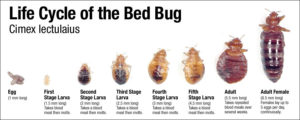Bed Bugs – Questions & Answers
What are bed bugs?
Bed bugs are small, flat wingless insects that are reddish-brown in colour. They do not fly or jump, but they can crawl rapidly. Bed bugs are nocturnal and are mostly active at night.
Where are they found?
Bed bugs hide in mattresses, bed frames, bedding, furniture, carpets, baseboards and bedroom clutter. They are most commonly found in the seams of mattresses or inside box springs.
What do they look like?
Bed bugs are small and flat insects that do not have wings and are reddish-brown in color. They are approximately one quarter of an inch or 5mm, before feeding (about the size and shape of a small apple seed).

How do I know if I have bed bugs?
You can see the bed bugs themselves, their shed skins, or their droppings in mattress seams and other items in the bedroom. There may also be blood stains on sheets and you may notice bites on your body.
How do they find you?
Bed bugs hitch hike…they do not cling to people but they can accidentally get caught up in our belongings (i.e. suitcase, purse, laptop bags). Bed bugs can come from other infested areas or from used furniture. They can hitch a ride in luggage, purses, backpacks, or other items placed on soft or upholstered surfaces. Bed bugs can travel between rooms in multi-unit buildings, such as apartment complexes and hotels.
How do they feed?
Ever heard the saying “Don’t let the bed bugs bite”? That’s because they do! They feed on humans and other warm blooded animals and are attracted by the carbon dioxide and warmth that is emitted. Bed bugs have been known to travel over 20 feet from hiding in order to feed but will generally hide within 3-6 feet of their host. Bed bugs can survive for up to a year without feeding!
How can I avoid getting bed bugs?
When staying in a hotel or hostel remember these bed bug travel tips –
– Inspect the hostel room, beds, couches, closets and floor for signs of bed bugs. On the mattresses, look for tiny red spots which might be blood stains from other travelers/hostel user/students who have occupied the room. Look for tiny black pellets (fecal matter) in all areas. You might even find dead bugs lying about the bed or underneath picture frames along the wall.
– Place your bag on a suitcase stand rather than on the bed or floor. Keep the rack away from walls or furniture. When returning home, wash the clothes from your trip and put them in a hot dryer. Inspect new and used furniture before bringing it inside. Look in seams, tufts and under cushions.
– Beware of musty furniture smell! Bed bugs give off a smell similar to that of old furniture. If the hostel room smells wet or musty or almond like, inspect it thoroughly as this is a surefire sign of bed bug activity.
– Read user reviews to ensure you are going to a bed bug free hostel in order to prevent being bitten by bugs. Make sure the reviews are recent.

Is there a risk of disease?
Bed bugs do not pose any health risks from communicable diseases but their saliva does contain proteins that can leave itchy red welts on some people. Bed bug bites can look very similar to bites from other insects like mosquitoes and fleas.
How can I stop myself getting bitten?
This is one of the most important questions because prevention is always much better than cure:
– Be aware – know where to expect bed bugs so that you know when to take precautions to protect yourself and your home.
– Use Insect repellent bug sheets – These sheets help to protect you while you sleep. They are treated with an insecticide which is harmful to insects and safe for humans. Usually, bed bug sheets will stop any creepy crawlies from coming through and if they’re too silly to hang around, the sheets will kill them. Perfect for hostels, hotels, groundsheets and general fitted sheets where you may need extra protection.
– Use an insect repellent clothing treatment – this can help to protect by spraying on any linen, towels or textiles. Clothing can also be treated with LifeSystems EX4 permethrin clothing spray to make it insect repellent.

